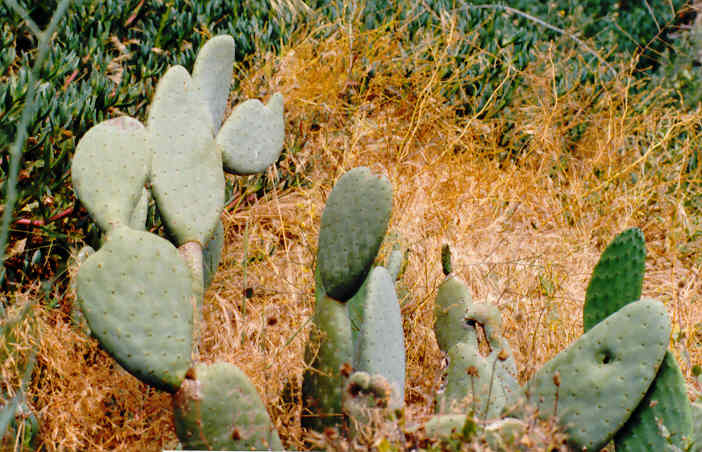
Opuntia ficus-indica (L.) Miller
Cactaceae
(Cactus Family)
Tropical America
 |
Opuntia ficus-indica (L.) MillerCactaceae
(Cactus Family)
Tropical America
Indian-Fig |
I
Plant Characteristics:
Tree 3-5 m. high, the trunk ca. 1 m. high, 2-3 dm. thick; joints green,
obovate to oblong, 3-6 dm. long, 2-4 dm. wide; spines none to many, white or
eventually some are tan, 1-6 per areole, some spreading, some deflexed,
straight, to 4 cm. long, not barbed; fls. inner perianth yellow or orange,
filaments pale green to pale pink; ovary tubercled, style white (pale pink),
stigma green; fr. 6-9 cm., juicy, yellow-orange or purple; areoles 43-71.
Habitat:
Cultivated in warm regions worldwide; native range unknown. Below 450 m.
Rarely naturalized. May-June.
Name: Old Latin name used by
Pliny, formerly belonging to some other plant.
(Munz, Flora So. Calif. 314).
Latin, ficus, a fig tree, a fig. (Jaeger
102). Latin, Indicus,
of India. (Jaeger 127). The fruits are fig shaped and were eaten by the native
American Indians. Thus, ficus-indica, fig of the Indians.
(John Johnson).
General:
Rare in the study area. There
are two plants on the bluff below the old Castaways Restaurant, one near the top
and the other and bigger one near the bottom.
I suspect that pads from the plant were thrown over the bank with other
trimmings and survived. The
restaurant burned in about 1957 so the plants have naturalized and persisted for
many years. I have never seen the plants in bloom and John Johnson
suggests that they may be sterile. (my
comments). This
large-growing Cactus was introduced into California from Mexico and was much
cultivated in hedge-rows in the days of the Spaniards and the early settlers.
Both Indians and whites made much use of the fruits of this plant and of
several others which are very much like it, notably Prickly-Pear, Opuntia
occidentalis. The fruits were
eaten raw, having been peeled carefully after removing the spines.
The flavor of the fruits of different species varies somewhat.
Another use for these plants, which is still current among the Mexican
population, is to gather the young joints before the spines have hardened, cut
them into strips and boil tender to serve as a vegetable.
A good pickle is also made from them.
The young growths are known as nopales.
Among the Indians the fully ripe fruits were gathered, dried and the
seeds winnowed out and stored, to be ground into flour for atole.
The pads were boiled and crushed, and the sticky juice resulting was
added to mortar or used in whitewash to make it stick more securely to adobe
walls. (Balls 35,36). The Chumash Indians, the bulk of whom
resided along the plain on the coastal side of the Santa Ynez Mountains, used
the introduced Opuntia ficus-indica
for paint, sealant, food and medicine. (Timbrook,
J. "Chumash Ethnobotany: A Preliminary Report".
Journal of Ethnobiology, Dec. 84, 141-169). Researchers at Tulane University in New Orleans have found that an extract
from O. ficus indica seems to cure some of the symptoms of a hangover
i.e., nausea, dry mouth and loss of appetite, however, other symptoms such as
dizziness and headaches were not helped. (no author, “Bender Mender” U.S.
News and
Probably 300 spp., from s. Canada to Straits of Magellan.
Hybridizes freely with native species.
(Munz, Flora So. Calif.
314,317).
Cultivated in warm regions world-wide; native range unknown.
(Hickman, Ed. 455).
Text Ref:
Hickman, Ed. 455; Munz, Flora So. Calif. 317; Roberts 17.
Photo Ref:
June 3 83 # 7.
Identity: by R. De Ruff, confirmed by F. Roberts.
First Found: June 1983.
Computer Ref: Plant Data 328.
No plant specimen.
Last edit 7/11/04.